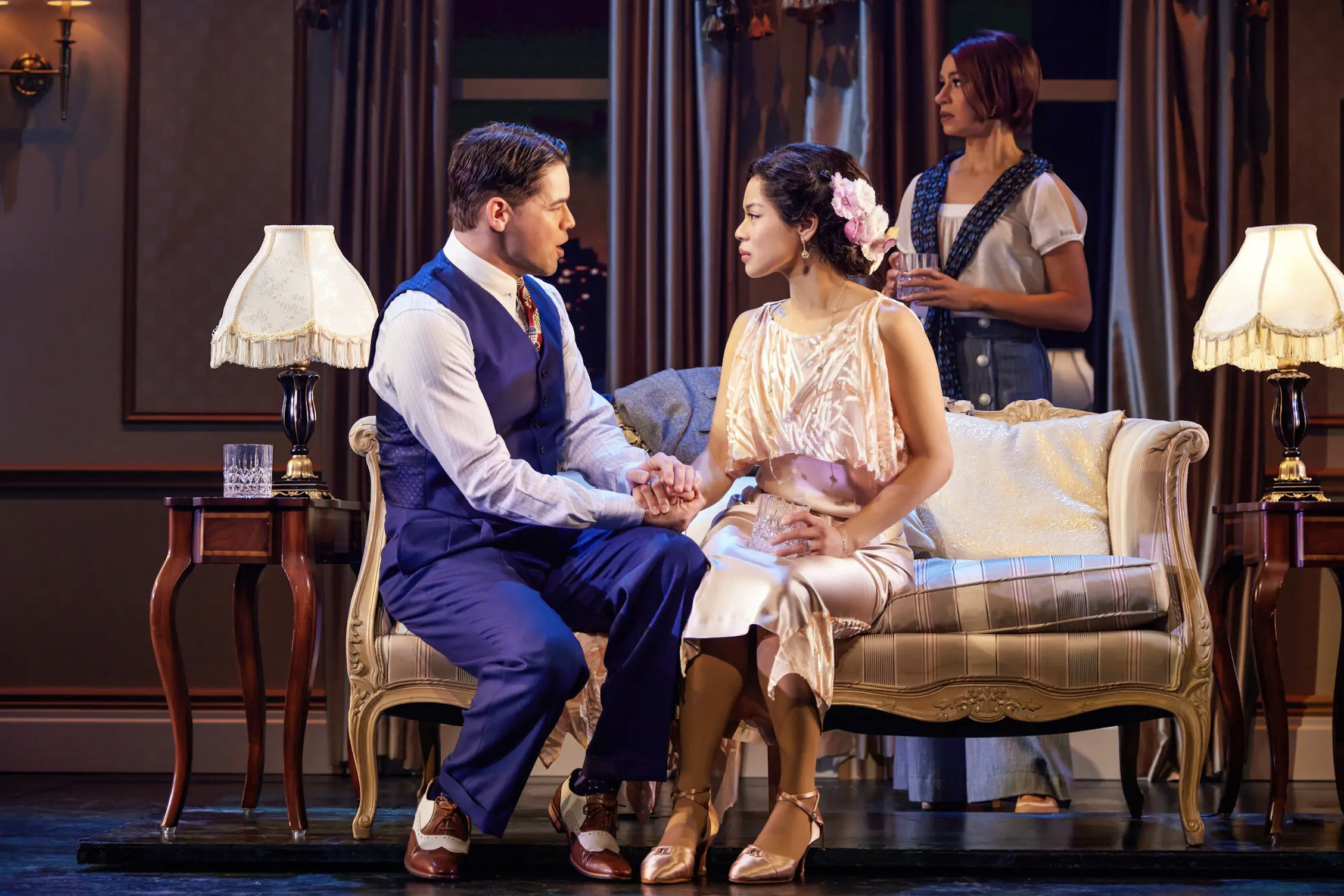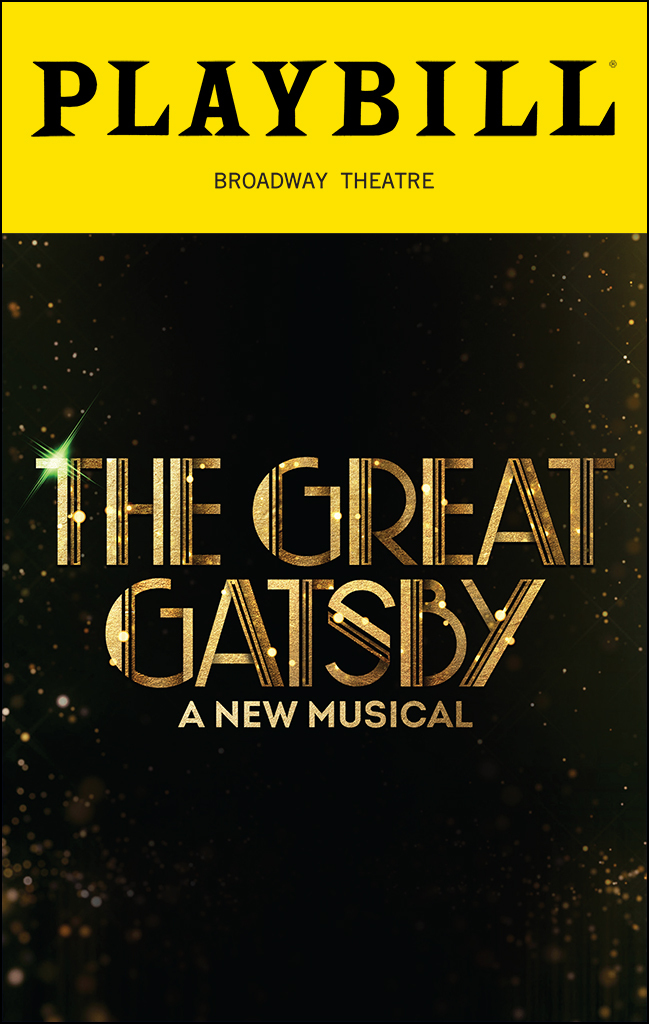Jay Gatsby — self-made enigma, party host extraordinaire and talk of the summer season in West Egg, Long Island — doesn’t carry his insecurities lightly. The facade of his wealth-drenched life is a grand and precarious creation, and propping it up requires constant vigilance.
His is new money, so he has to prove his worth to the snobberati. Thus his pathetic habit of showing that photo of himself in his Oxford days to people he has barely met. Or, more endearingly, his over-the-top insistence on glamming up the humble cottage of his neighbor, Nick Carraway, when the lost love of Gatsby’s life, the fabled Daisy Fay Buchanan, is coming over for tea.
In the new musical “The Great Gatsby,” which opened on Thursday night at the Broadway Theater, the grass outside the cottage is groomed, flowers are everywhere, and a fleet of servants is ferrying food. And Jeremy Jordan’s Gatsby is an adorably panicked basket case, second-guessing in charming comic song his plan to ambush Eva Noblezada’s Daisy with a reunion.
“She is late, so I’m off to go scream in a jar,” he sings, but Daisy arrives before he can flee. Unsuavely, he topples into some greenery.

It’s a perfectly winsome scene, and a highlight of this ultimately underwhelming new adaptation, which has a book by Kait Kerrigan (making her Broadway debut), music by Jason Howland (“Paradise Square”) and lyrics by Nathan Tysen (also “Paradise Square”). Comedy and romance are strong suits of this production by Marc Bruni (“Beautiful: The Carole King Musical”), which ran in the fall at the Paper Mill Playhouse in New Jersey.
There are plenty of big dance numbers, too (by Dominique Kelley), with some standout tap. The 1920s costumes (by Linda Cho) are fun to look at, Daisy’s in particular: all those handkerchief hemlines, wafting on air. Gatsby’s yellow Rolls-Royce and Tom’s blue coupe drive onstage, extravagantly. And while the fireworks we see in the distance are projections, other sparkling pyrotechnics are delightfully real.
The darker elements of “The Great Gatsby” prove more elusive, which blunts the impact overall. So does the show’s anodyne Broadway sound, which is poppy and pleasant without being memorable. It summons neither the Jazz Age, like the soundtrack to Jack Clayton’s 1974 movie adaptation did, nor a spirit of wild abandon, like the soundtrack to Baz Luhrmann’s 2013 take. The score to this “Great Gatsby” is missing a vital urgency.
This is not, by the way, the other high-profile musical adaptation you may have heard about since F. Scott Fitzgerald’s 1925 novel entered the public domain in 2021. Next month, the Tony Award winner Rachel Chavkin directs “Gatsby,” with a book by the Pulitzer Prize winner Martyna Majok and a score by Florence Welch and Thomas Bartlett, in Cambridge, Mass.
Bruni’s Broadway production has the tremendous asset of a terrific core cast, including Noah J. Ricketts as the decent, disillusioned narrator, Nick, who, in this telling, is for some unnecessary reason Gatsby’s tenant Samantha Pauly as Jordan Baker, a famous golfer and anti-marriage New Woman who enjoys a screwball romance with Nick and John Zdrojeski as Tom Buchanan, Daisy’s pampered, polo-playing bully of a husband.
She should of course be rid of him. Still, they are a handsome pair their clothes, screaming silently of luxury, hang elegantly on them both. Their infant daughter, Pammy, wears less flattering clouds of lace. When Jordan objects to such little-girl outfits on principle, Daisy replies with absolute nonchalance: “But there’s nothing to be done about that. It’s how babies dress.”
Noblezada and Pauly are easy with humor, and Kerrigan has taken care to deepen Daisy and Jordan, who, with their talk of the limitations of life for women, sound practically “Suffs”-adjacent. Noblezada gives Daisy steel at her center that further ensures she isn’t a manic pixie dream girl, even if the incurably dreamy Gatsby perceives her through gauze.
As for theatrical illusion, it, too, is precarious at Saturday’s matinee, technical glitches shattered it repeatedly in Act I. Projections, integral to Paul Tate dePoo III’s set design, would blink out and disappear, leaving vast expanses of matte black screen where a vision of splendor had been.
And so it was for Gatsby’s and Daisy’s reunion. There they stood in front of the cottage, laying eyes on each other for the first time in years, when much of the little house and its surrounding copse — the parts that aren’t three-dimensional scenery — abruptly vanished, along with the ambience. A bit on the nose for a show with mirages as a theme, and more than a bit distracting.
Even with flawless tech, the projections have a hyper-vividness reminiscent of video games. If that’s a deliberate attempt to question the solidity of all the sumptuousness — like the sozzled party guest in Fitzgerald’s novel who, wandering into Gatsby’s library, is astonished to find that the books are real — the aesthetic is nonetheless jarring, particularly for a show set a century ago.
The musical’s truly unbalancing trouble, though, is its rendering of Tom’s affair with the working-class Myrtle Wilson (Sara Chase), the one character the show doesn’t take seriously or treat with dignity. Even when tragedy befalls her, there’s a laugh line in the immediate aftermath. We know more about Myrtle’s husband, George (Paul Whitty), the gas station owner, than we do about her. And what we do know is so one-note tawdry that it’s difficult to believe Tom would set up an entire down-low life with her.
The implosion of the summer hinges not only on Daisy and Tom’s notorious, soul-corrupted carelessness, but also on the Wilsons. No matter how much this adaptation wants to riff on other elements, it needs to set up their part of the story so that the wider devastation lands.
But this “Great Gatsby,” which is not terribly bothered, either, with the moral shadings of its title character’s rise and fall, is principally interested in a good time. When Nick utters the novel’s sober final line, about “boats against the current,” the words have no heft. An ensemble of dancers is upstaging him anyway, wanting to give the audience one last moment at the party.

